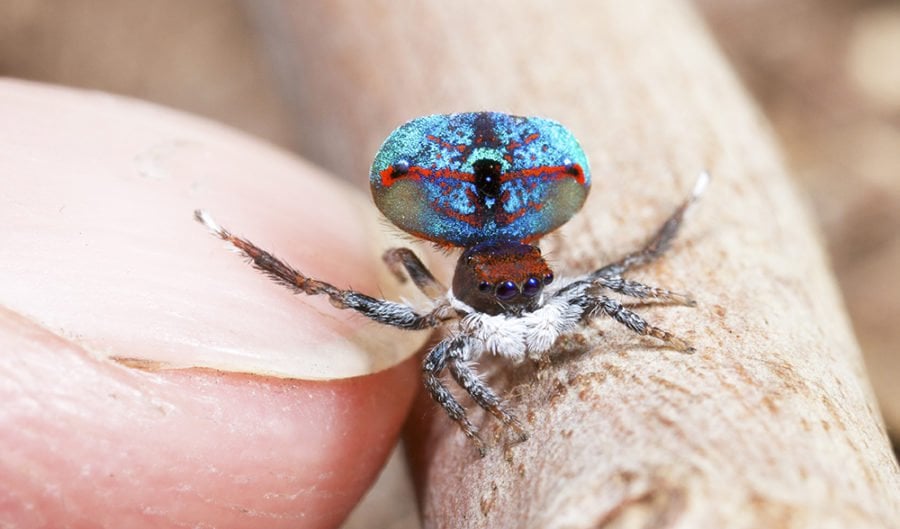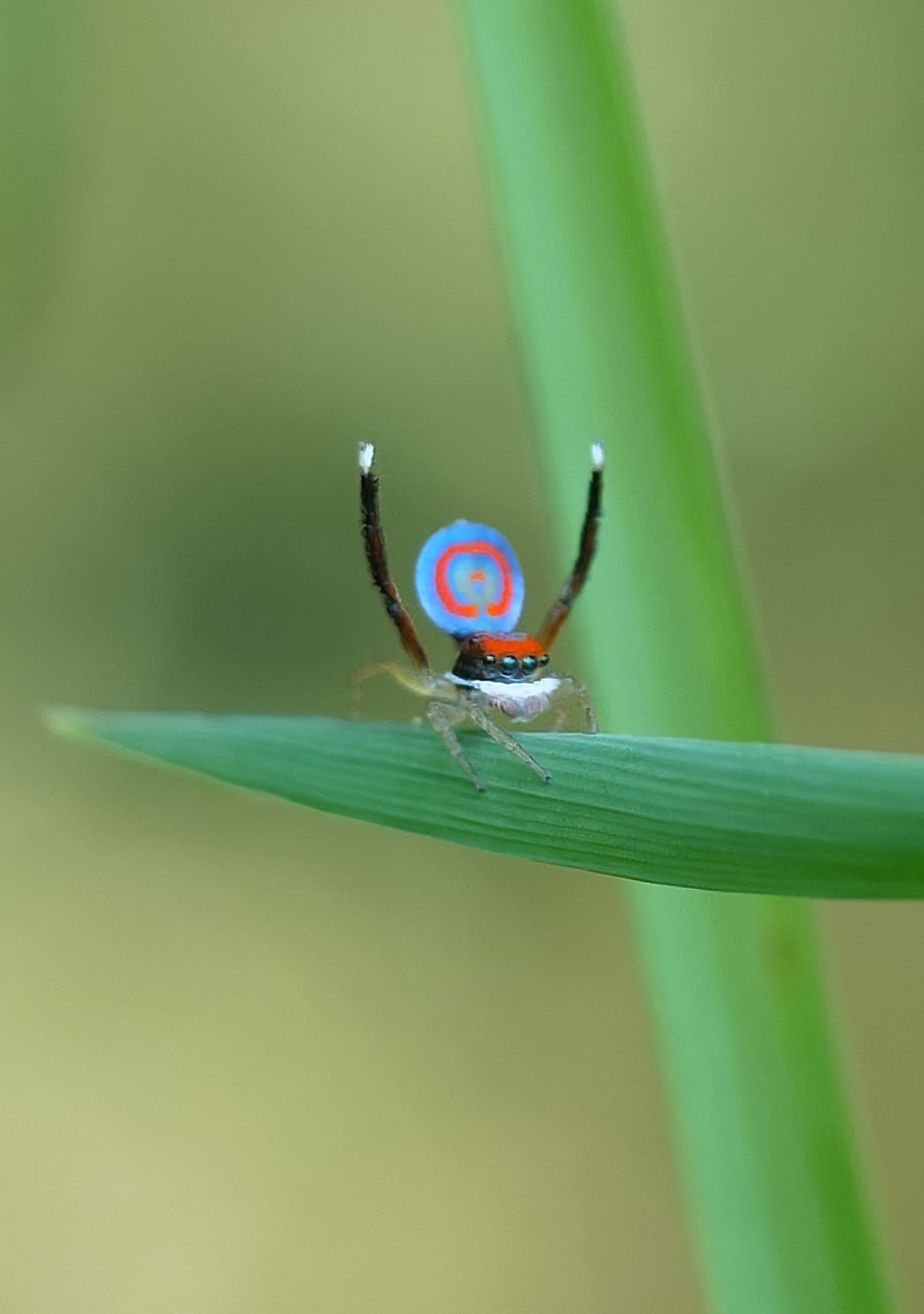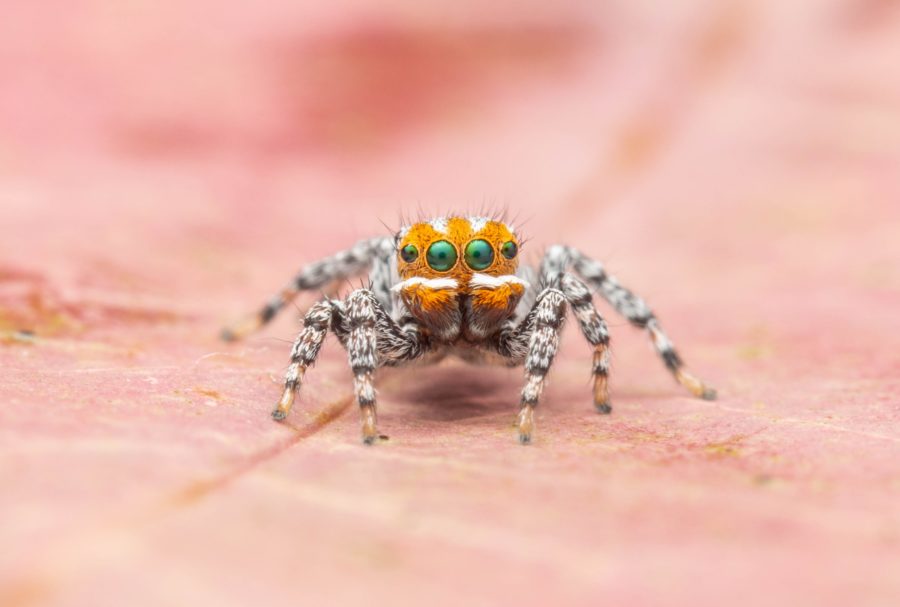Dance of the tiny peacock spider

In a sunlit room, in the bushland-fringed Sydney suburb of St Ives, photographer Dr Jürgen Otto examines a plastic sample vial. He unscrews the lid, and, tilting the cylinder, gently taps it with his finger. A puff of soil particles and a flash of brilliant blue tumble out and settle on a bush-floor diorama.

Jürgen’s German accent is little diluted by the several decades he’s spent in Australia. “Come on, there she is,” he mutters, eyeballing a teeny Harris’s peacock spider. His finger gently shepherds it towards a plain brown female already on set. The furry blue flap curled around the male’s pencil tip-sized abdomen is studded with dots and stripes and flanked by leaf-green panels. “Here we go. He sees her,” Jürgen -whispers, glancing at me.
Two of the male’s furry legs rise like poles at a 75° angle and the iridescent, blue-green flap unfurls and pops up. Jiggling the flap frenetically between the V of his upright legs, the spider waggles about with the high-octane energy of a fly.
Seconds later the female, looking uninterested, turns the cold shoulder on him. The male continues to jiggle and showboat, in a last-ditch attempt to capture her attention, so Jürgen plonks in a finger and hooks him out. “Just in case she eats him,” he says wryly, returning the male to its vial.
Australia’s peacock spider species are the most attractive of the world’s more than 5000 species of jumping spider. At a tiny 4–6mm long, they stand out because of their small size, their relatively large eyes and, of course, the male’s dazzling opisthosomal fan. This is a flap on the abdomen covered in bright iridescent scales, which makes it appear similar to a butterfly wing.
Peacock spiders a YouTube favourite
The fans are bold in themselves but it’s the male’s unique courtship dance that has caught people’s attention, especially online.
Jürgen’s YouTube channel has attracted more than 3.6 million views. In a mash-up of his footage by another user, one male’s acrobatic legs make traffic-controller-like gestures to the rhythm of Y.M.C.A. by the Village People; and footage of a coastal peacock spider is slowed as it does a sort of peculiar overhead clap. Each species has its own unique choreography.
Most begin by waving their legs to get the female’s attention, then follow with a dance using their third legs and opisthosomal fans. They also use rotating appendages called spinnerets (which other spider species use to spin webs) and vibrate their abdomens. The dance can last anywhere from 10 seconds to two hours.
Today, the spiders’ fame has spread well beyond YouTube. Last year Jürgen’s videos were on show at the Museum of Contemporary Art in Sydney; peacock spider-inspired handbags and shoes have been shown on Bangkok catwalks; and their dance was even the inspiration for a performance by Harvard University students in 2012. Recently, the American Museum of Natural History, in New York, used Jürgen’s footage and images for a spider exhibit, as has the Natural History Museum of Denmark in Copenhagen.
Despite the males’ harlequinesque get-ups, peacock spiders were largely overlooked by science before Jürgen pointed his lens at them almost a decade ago. Since then, the number of described Australian species has jumped from seven to 29 – 12 of which were named by Jürgen and his American collaborator, David Hill.
Peacock spiders dance to attract a mate
“Peacock spiders are really extreme, even in the jumping-spider world,” says Maddie Girard, at the University of California, Berkeley. She’s midway through a PhD study of the group, despite living on the other side of the world. For her research, Maddie amplifies the vibrations coming off surfaces around the spiders, to listen to the complex soundtrack they create by whacking their abdomens on the ground, or vibrating their legs. “I can identify a dud male…just based on sounds a lot of the time,” she says.
It’s thought that the female doesn’t hear this drumming, but feels it through her legs. “You get a male who’s older and seemingly weaker, and his sounds are a lot more muddled,” Maddie adds. In short, the performance is about the females selecting the males with the best genes, she says.
Jürgen, a sandy-haired 49-year-old, is actually an acarologist. In other words, he’s a mite specialist, and his day job involves looking for even tinier creatures for the Department of Agriculture, Fisheries and Forestry. “It’s probably one reason I find looking for spiders quite easy,” he says. “A 4mm spider – that’s a huge thing for me.”
His St Ives home is a stone’s throw from Sydney’s Ku-ring-gai Chase National Park. This is one of the locations where you can find Maratus volans, commonly known as the flying spider. Jürgen’s very first peacock spider encounter was with a specimen of this spectacular orange-and-turquoise species.
He says that, almost a decade ago, he was a frustrated semi-professional wildlife photographer. He had been scrabbling for subject matter on the east coast after working with tropical wildlife subjects in Townsville for nine years. “I eventually started to photograph flowers,” he says. Then, while out on a bushwalk, he spotted something jumping in the leaf litter.
Research continues on peacock spiders
The flying spider was named in 1874, says Jürgen. But, “strangely enough the person who first caught it, Henry Bradley, made up the story [about flying]”. Jürgen explains that Bradley told his story to the leading arachnid expert in England at the time, who wrote the first record of the spider. The flight myth followed the spiders around for the next 130 years.
The truth is they’re nimble, but the physics are all off, says Julianne Waldock, a technical officer at the Western Australian Museum in Perth, who devotes some of her spare time to researching these spiders. In 2007 she presented a paper pointing out that there’s little evidence that these creatures glide. It wasn’t until 2008, when Jürgen captured images of the dance of M. volans for the first time, that people came to know more about their miniature performances.
Their internet stardom has had a knock-on effect scientifically. Jürgen’s computer is full of files labelled, for example, ‘orange blotches’ or ‘blue face’ – temporary names for undescribed species, a few sent to him by photographers around the country. Indeed, the Harris’s peacock spider I watched dance was named after Canberra vineyard worker Stuart Harris who tramped through the bush for more than 150 hours to find another example of the then-unnamed species after Jürgen commented on a picture he posted online.
“There are no scientists working professionally in this field – we’re all amateurs,” Jürgen says. “We wouldn’t know about most of these species if it wasn’t for amateurs.” They’re certainly less well known than mites, he says, maybe because they’re not pests.
“Macro photography is really huge now,” he says, “and people think of these spiders as the Holy Grail… I think one day they will be as famous as kangaroos and koalas. I really do.”


